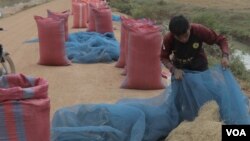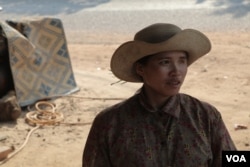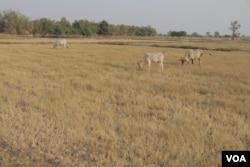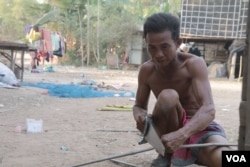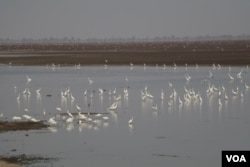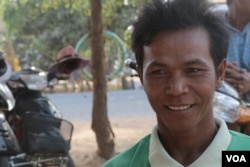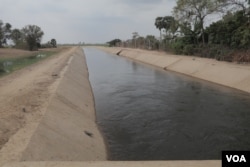Trapaing Thmar reservoir, the largest of the Khmer Rouge regime’s irrigation projects built atop the bones of the dead, is running dry amid one of the worst droughts to hit Cambodia in living memory.
In northwestern Cambodia, over 400 kilometers from Phnom Penh, the vast protected area serves as a crucially important water store for thousands of rice farmers and their families in Phnom Srok district and other neighboring areas.
Trapaing Thmar reservoir also provides a home to a number of endangered species, including the Sarus crane.
During a recent visit to the area, farmers were fishing and pumping water to their rice field from small ponds that are all that remains of the more than 12,000-hectare reservoir.
In Banteay Meanchey province’s Phnom Srok district, farmers complain that there is a scarcity of rain, both during the wet and dry season.
“It is not like before. It is worse than ever,” says Ping Chantrea, a 30-year-old farmer who adds she can no longer produce enough rice.
“It only rained twice during the wet season last year,” she laments from her home in Ponley commune’s Porabun village, as other farmers sit around and share their concerns over the lack of rainfall.
“And now early this year until now, it has not rained at all,” said another farmer, who is at eight-months pregnant.
“I lost the money I saved from my wedding,” she says.
Cambodian farmers harvest rice in two seasons: the rainy and dry seasons. Farmers in this district have complained that production of paddy rice in both rainy and dry seasons has declined. Cambodia’s rainy season typically arrives in May and ends in October.
Another farmer, Laing Thom, says the temperature is rising and the rains not regular.
“Now it is only about 8 am, but it is very hot,” says Thom.
Cambodia has been ranked among the countries most vulnerable to the impacts of climate change in Southeast Asia. The impacts may already be being felt.
Thom says he cannot produce much rice on his 2.6-hectare farm.
“I can’t make a profit, or even cover the cost of fertilizer,” he adds, complaining of price manipulation.
‘No More Rice Farming’
On February 20, Prime Minister Hun Sen called on farmers to stop rice farming during the dry season this year due to the drought.
“I want to call on all authorities to advise all people not to do dry-season rice farming... Please do farming only one time this year because we do not have enough water,” Hun Sen told thousands of garment workers in Kandal province, adding that Cambodia will face severe drought and water shortages this year.
In a directive dated January 17, Hun Sen called on local authorities and villagers to save water from natural reservoirs for daily use and crops.
Cambodia will likely be indirectly impacted by a phenomenon called El Nino, which refers to a short-term period of warm ocean surface temperatures in the tropical Pacific, stretching from South America towards Australia.
Cambodia will also grapple with soaring temperatures of between 40 and 42 degrees Celsius in April and May.
Lim Kean Hor, minister of water resources and meteorology visited Trapaing Thmar reservoir in Phnom Srok district on the morning of February 23. He said villagers in Phnom Srok villagers had broken the rules by farming during the dry season, against the direction of the prime minister.
“They have farmed more than the plan allowed. They were allowed to do only a total of 5,000 hectares of land,” said the minister.
“We lack water,” he said, adding that rain might fall in mid-May.
Impacts on Farmers
The drought has now affected over 20,000 hectares of rice fields in 13 provinces, according to the National Committee for Disaster Management.
In 2015, Cambodia experienced its worst drought in half a century, with most of its 25 provinces experiencing water shortages, and about 2.5 million people severely affected.
Mean Seum, chief of Chantrea’s Porabun village, said it is estimated that only 10 percent of the normal amount of paddy rice will be produced this year.
“Mostly they owe money to microfinance [institutions] and other people,” he said. “The debt will be more.”
“If it is worse like that in the future, parents will migrate to work in Thailand or children will be forced to work,” he added.
“There is no family in this village whose members don’t go to Thailand,” he said, adding that the migrants work in construction or agriculture.
Normally the migrant workers return to help their families with the harvest. “But they won’t come this year,” he added.
Seum himself has three-hectares of land and rents two hectares for farming. But he cannot break even in the current climate, he says.
“People also get angry with each other because some families get water for their rice fields and some don’t,” he adds.
Em Dara, the technical assistant at the Ministry of Water Resources, who oversees the reservoir, said about 5,000 hectares of land have been affected so far.
“It has affected thousands of families,” he said. “Some don’t have water to use now.”
“It has affected species and fish in the reservoir as well. The climate has changed now. It is the worst in ten years,” he said.
The reservoir can store up to 180 million cubic meters of water but now holds less than 1 million cubic meters, according to Dara.
Villagers are also concerned about the impact on fish stocks.
“There is no water. This year is worse than other years,” says Mea Siz, 58, who is fishing at Trapaing Thmar reserve. “I am now concerned about fish here.”
Taking a Chance
Having land to farm crops, especially rice, is the most important thing in many Cambodians’ lives. It is what gives them a sense of security, community, and family. Eighty-five percent of Cambodia’s approximately 16 million people still depend on subsistence agriculture for their livelihoods.
Despite being aware of the water shortage, farmers in this district say they have decided to carry on farming through the dry season.
“I could not make rice during the rainy season, so I decided to do in the dry season, but it was not successful,” says Chantrea.
“I thought that the water in the reservoir was enough, but it was not because many farmers have done farming at the same time and the water is insufficient,” she adds.
Deu Yuch, another farmer, says the poor farming conditions have led him to fall into $3,000 of debt.
“I don’t know what to do, but will keep growing rice in the next season,” he says. “We have no choice. We have to take a chance.”
Some parts of the community have been provided water from an irrigation system built by Chinese investors. The water has been transported from nearby provinces -- Siem Reap and Oddar Meanchey -- according to Khut Khuon, a Poichar commune chief.
Khuon says during the Khmer New Year farmers will hold a ceremony to pray for rain.
“We will ask the Buddha to give rain,” he says.
As the drought continues to blight the countryside, Chantrea says she is worried that it will get worse and she will not have enough water to farm in the wet season.
“What can I do? I have to take the chance to do it.”
Another farmer, Laing Thom, says rice farming is all the community knows. He said villagers would attend the ceremony at Khmer New Year to seek help from Tevada, a guardian angel figure in Khmer spiritual belief.
“We are farmers, but if we don’t do farming, what do we have to eat? So I take a chance with Tevada. I pray to Tevada to bring rain so it will be cold and have water.”




